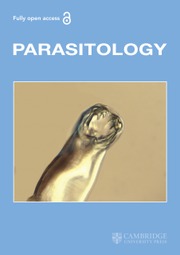Crossref Citations
This article has been cited by the following publications. This list is generated based on data provided by
Crossref.
Anderson, R. M.
and
May, R. M.
1982.
Coevolution of hosts and parasites.
Parasitology,
Vol. 85,
Issue. 2,
p.
411.
1983.
The Florey Lecture, 1983 - Biological control, as exemplified by smallpox eradication and myxomatosis.
Proceedings of the Royal Society of London. Series B. Biological Sciences,
Vol. 218,
Issue. 1212,
p.
259.
Bremermann, Hans J.
and
Pickering, John
1983.
A game-theoretical model of parasite virulence.
Journal of Theoretical Biology,
Vol. 100,
Issue. 3,
p.
411.
1983.
Epidemiology and genetics in the coevolution of parasites and hosts.
Proceedings of the Royal Society of London. Series B. Biological Sciences,
Vol. 219,
Issue. 1216,
p.
281.
McCallum, H. I.
and
Anderson, R. M.
1984.
Systematic temporal changes in host susceptibility to infection: demographic mechanisms.
Parasitology,
Vol. 89,
Issue. 1,
p.
195.
Kennedy, C. R.
1984.
Producers and Scroungers.
p.
34.
Ross, J.
and
Sanders, M. F.
1984.
The development of genetic resistance to myxomatosis in wild rabbits in Britain.
Journal of Hygiene,
Vol. 92,
Issue. 3,
p.
255.
Wakelin, D.
1984.
Evasion of the immune response: survival within low responder individuals of the host population.
Parasitology,
Vol. 88,
Issue. 4,
p.
639.
Hadeler, K. P.
and
Dietz, K.
1984.
Population dynamics of killing parasites which reproduce in the host.
Journal of Mathematical Biology,
Vol. 21,
Issue. 1,
p.
45.
Thompson, S.N.
1985.
Metabolic integration during the host associations of multicellular animal endoparasites.
Comparative Biochemistry and Physiology Part B: Comparative Biochemistry,
Vol. 81,
Issue. 1,
p.
21.
Mulvey, Margaret
and
Woodruff, David S.
1985.
Genetics of Biomphalaria glabrata: Linkage analysis of genes for pigmentation, enzymes, and resistance to Schistosoma mansoni.
Biochemical Genetics,
Vol. 23,
Issue. 11-12,
p.
877.
1985.
A Paradigm for the study of insect-ciliate Relationships:
Tetrahymena sialidos
sp. nov. (Hymenostomatida: Tetrahymenidae), Parasite of Larval
Sialis Lutaria
(Linn.) (Megaloptera: Sialidae)
.
Philosophical Transactions of the Royal Society of London. B, Biological Sciences,
Vol. 310,
Issue. 1143,
p.
123.
Minchella, D. J.
1985.
Host life-history variation in response to parasitism.
Parasitology,
Vol. 90,
Issue. 1,
p.
205.
Thompson, John N.
1986.
Constraints on arms races in coevolution.
Trends in Ecology & Evolution,
Vol. 1,
Issue. 4,
p.
105.
CHENG, THOMAS C.
1986.
General Parasitology.
p.
1.
Sitepu, Petrus
Brindley, Paul J.
and
Dobson, Colin
1986.
Nematospiroides dubius: Direct and correlated responses to selection for high and low immune responsiveness in mice.
Experimental Parasitology,
Vol. 61,
Issue. 1,
p.
57.
Massad, Eduardo
1987.
TRANSMISSION RATES AND THE EVOLUTION OF PATHOGENICITY.
Evolution,
Vol. 41,
Issue. 5,
p.
1127.
Kino, H.
and
Kennedy, C. R.
1987.
Differences in biological characteristics of two strains of the cestode Hymenolepis diminuta.
Parasitology,
Vol. 95,
Issue. 1,
p.
97.
EWALD, PAUL W.
1987.
Insect Outbreaks.
p.
269.
Lenski, Richard E.
1988.
Evolution of plague virulence.
Nature,
Vol. 334,
Issue. 6182,
p.
473.

